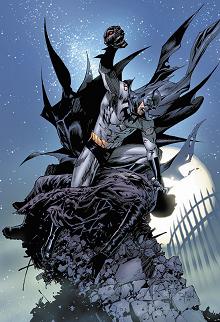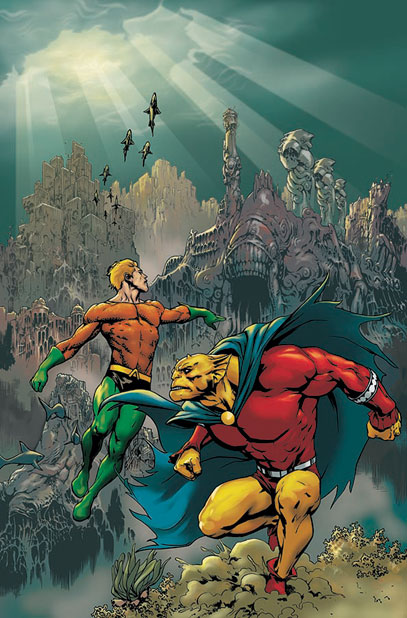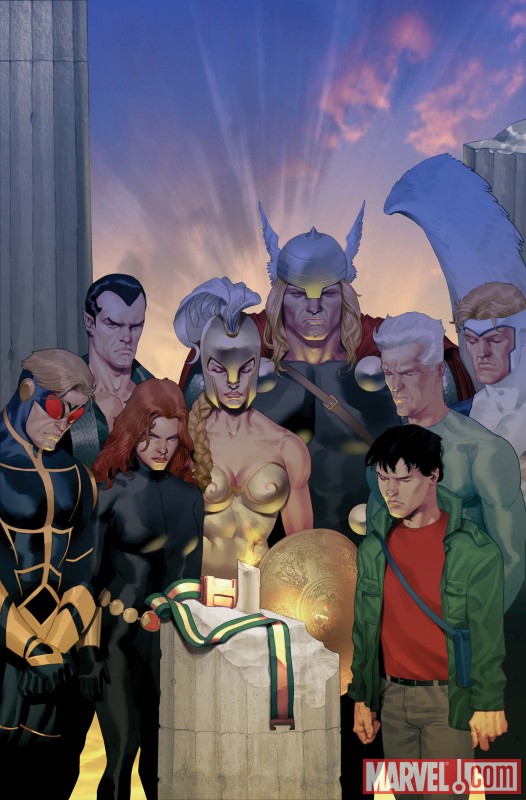Batman #697:

This was the best issue in Tony Daniel's "Life After Death" arc, which is too bad since it was also the finale. The long-teased identity of the Black Mask is revealed, and without giving it away, I can say that it's familiar face, and not the biggest surprise. However, the real highlight here (other than Catwoman getting a sidekick) is Daniel's Dick Grayson. Daniel's art has always been impressive, but in this issue his writing is finally on par with the pencils. Especially in the last few scenes, it's clear that this story was really about Grayson coming into his own under the cowl, and not so much about the Black Mask. Unfortunately, the ending of the book feels like the beginning of the end for Grayson's tenure at Batman, which is a shame. I've heard it repeated elsewhere, but bringing Bruce Wayne back might be the worst thing to happen to the Bat-Books. Things are very interesting right now, and returning the Batman back to the status quo feels like a bit of step in the wrong direction. I have no doubts that the Return of Bruce Wayne story will be fantastic, but I have substantial concerns regarding what it will mean in the long run.
Brave and the Bold #32:

For a creative run that so far has turned out some of the best one-and-dones I've ever read, this was a great, but not amazing issue. I've never read an Aquaman story before in my life, and this is my book of the week, which is saying something. In changing up the style and telling a horror story of the sea, Straczynski once again proves that Brave and the Bold is the best superhero book currently hitting the shelves. After five solid issues of expert superhero storytelling, it's clear that Straczynski's writing thrives when he doesn't have to worry about continuity or crossover events. Time and again, Brave and the Bold has revitalized my interest in characters I had previously ignored (like Dr. Fate in #30) or never even heard of (like Brother Power in #29). This time it's Aquaman, due in no small part to Jesus Saiz's phenomenal art. As much as Straczynski is a master of the comic script, Saiz's control of the panel is stunning. The Demon is also great in this issue, although he plays a much smaller role than Aquaman. Hitting all the key notes of Lovecraftian fever dream (a delirious fisherman, grave robbing, and a Cthulu-type demon), this is an expertly crafted, imaginative comic, one that deserves a place in your collection.
The Bronx Kill (Vertigo Crime):

Though far from a crime classic, The Bronx Kill is one of the more enjoyable, and addicting, graphic novels to be released under the relatively new Vertigo Crime imprint. The story follows Martin Keane, a semi-successful novelist who has spent the majority of his life running from his family's professional legacy of service in the NYPD. As a child, Martin's father brought him to the site of his great grandfather's murder, the Bronx Kill river, to try and inspire him to become a cop. As a grown man, Martin brings his wife to those same shores; in doing so, he unwittingly sets off a string of events that will unearth a dark family history and the truth behind his great grandfather's murder. Peppered into the story are prose excerpts from Keane's latest novel, and instead of distracting from or slowing down the main action, they reveal another layer to our frantic protagonist. Much of the Bronx Kill is spent slowly building an suspenseful atmosphere of fear and paranoia, in much the same vein as Hitchcock's better thrillers. Unfortunately, the build-up is better than the payoff, and the mystery is revealed a little too conveniently. Despite the unfulfilling reveal, the Bronx Kill is a definite page-turner: I was able to devour the book between four separate train rides in a single day, and it felt great. If you're a dedicated fan of the Vertigo Crime series thus far, I'd say pick it up; if not, find a friend who is, then steal it while he's not looking.
Marvel:
Dark Avengers #14:

In what is definitely one of the darkest issues in the series, we're reminded just how deeply sinister the Dark Avengers are, especially Bullseye. Lately, Bullseye has been regulated to the role of sadistic comic relief, which is part of what makes him so enjoyable. However, it was about time we were reminded of what makes him such a true villain: Bullseye delights in killing the helpless just as much as he does the super-powered. So while body count isn't as high as it's been in the past, his on-page murder of a female character will resonate with conscious readers for a long time. Other than that, this issue is an important companion to Siege, as it leads directly into the events of Siege #3. As Dark Avengers nears it's conclusion, I'm reminded that open-ended series are rarely as good as the shorter, more realized titles, such as this one. It'll be too bad to see them go, but something tells me we're in for one hell of a swan song.
Hercules Fall of an Avenger #1:

This issue was alright, but really felt like a bridge between Incredible Hercules and the upcoming Amadeus Cho seires. Here's what happens: a bunch of Marvel heroes stand around talking about why they loved the Lion of Olympus, and at the end a bunch of Gods show up to talk to Amadeus Cho about his destiny. The best part of the book is the fantastic Agents of Atlas back-up feature, wherein Venus and Namora take a trip to close out Hercules's remaining earthly affairs. The troubling thing about Fall of an Avenger is that after I finished it, I was left wondering if I really want to read an Amadeus Cho series sans Hercules. In a landscape of overly austere characters and dramatic absurdities, Hercules has always been a breath of brawny fun and the Marvel U is definitely going to be less fun without him. By spending the entire book reminding us of what makes Hercules such a fun character, Greg Pak sort of undercuts the upcoming Amadeus Cho book. I'm not going to count Amadeus Cho's series out just yet, because I have full faith in Pak's skills as a writer; but even still, I'm hoping that Hercules's absense will be short-lived.
Image:
Choker #2:

While the first issue left me a bit cold, Issue #2 doused those lukewarm feelings in gasoline and burned them to the ground. What changed? Well not a lot, but here's just a taste of what you'll get with Choker #2: super-juiced police, canibalistic freaks, poison coffee, batshit insane drug lords, an evil hand and severed testicles. If the series continues to be this weird, Choker will turn out to be the Grand Guignol comic that I'd hoped it would be. I can't wait to see where this story is going. Maybe I'm a bit caught up in my own excitement, so it might be too early to tell if the conclusion of the case will be as good as the ride, but right now that doesn't really matter. On top of the gleefully twisted art of Ben Templesmith, this issue contained some of the funniest dialogue I've seen in awhile. If you haven't already, now is the time to get your ticket to this wickedly demented, city-wide freakshow.
Misc:
The Green Hornet Year One #1 (Dynamite):

Matt Wagner writing Green Hornet one is like potatoes and gravy: it just makes sense. Delicious, delicious sense. Wagner's strength lies in writing pulp stories that don't take themselves too seriously, injecting a sense of atmosphere and fun that is sorely missed elsewhere. The 1930s gangster speak is a joy to read, as are the Green Hornet's one-liners. Like the cast of DC's First Wave, this is another pulp character I was completely unfamiliar with, and this issue makes me eager to know more. The narrative alternates between the present day 1938 and our duo's respective upbringings, making Green Hornet Year One the perfect series for my fellow uninitiated readers. Aaron Cambpell's art is a sight to behold, especially during the aforementioned Gangster scene. Wagner and Campbell make for a perfect comic book team, exemplifying all the best aspects of professional pulp storytelling.
The Muppet Show #3 (Boom Kids!):

Beyond a couple of slow panels tripped up by too many characters and too much dialogue, there's really nothing bad to say about the third issue of the Muppet Show. Roger Langridge deserves every Muppet fan's personal thanks for writing a series that effectively captures the spirit of the original television series without shoehorning the Muppets into a story other than their own. Langridge has given the original Muppet formula new life, and he deserves praise for his unparalleled ability to conjure up the character's original voices in the mind of the reader. In this issue most of the Muppets return to their newly renovated theater, while Gonzo and Fozzie travel back by more unconventional means. This real stars of this issue are Statler and Waldorf, who find that their heckling skills suffer greatly when there's no Fozzie Bear around. In the end, the balcony-bound duo even get a little bit of respect, making for one of the more satisfying and memorable final pages of the week.
Muppet King Arthur #3 (Boom Kids!):

Of all the auxiliary Muppet titles to come along (ie Muppet Peter Pan and Muppet Robin Hood), Muppet King Arthur has been the most enjoyable thus far. This issue sees the knights of King Kermit's court heading out on their first quest, and despite all their best efforts, we still don't know if they'll ever find a decent reuben sandwich. Writer Paul Benjamin does right by giving each main character their own time to shine, and there's a couple of hilarious image based jokes that legitimately made me laugh out loud while reading. Plus, I'm always happy to see Scooter. Before the end, there's even a bit of Muppet treachery on the part of an unlikely pairing of a patriotic bird and an under-appreciated frogling. But yet again, the best part of Muppet King Arthur is the A cover by David Peterson. They are simply a joy to look at, and even if I knew I hated the story, I still would've bought this issue based solely on the strength of Peterson's cover. Though it's still early in the year, I already know that these will make for some of my favorite covers of 2010.

 Point yer podcatcher here!
Point yer podcatcher here!
No comments:
Post a Comment